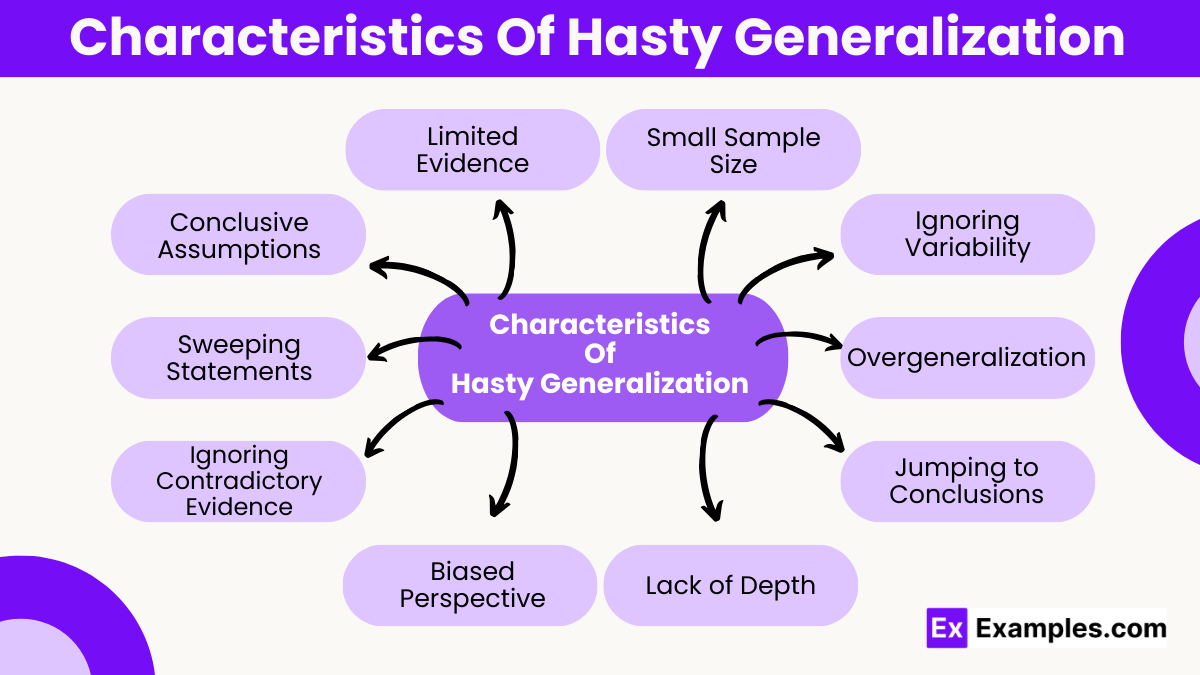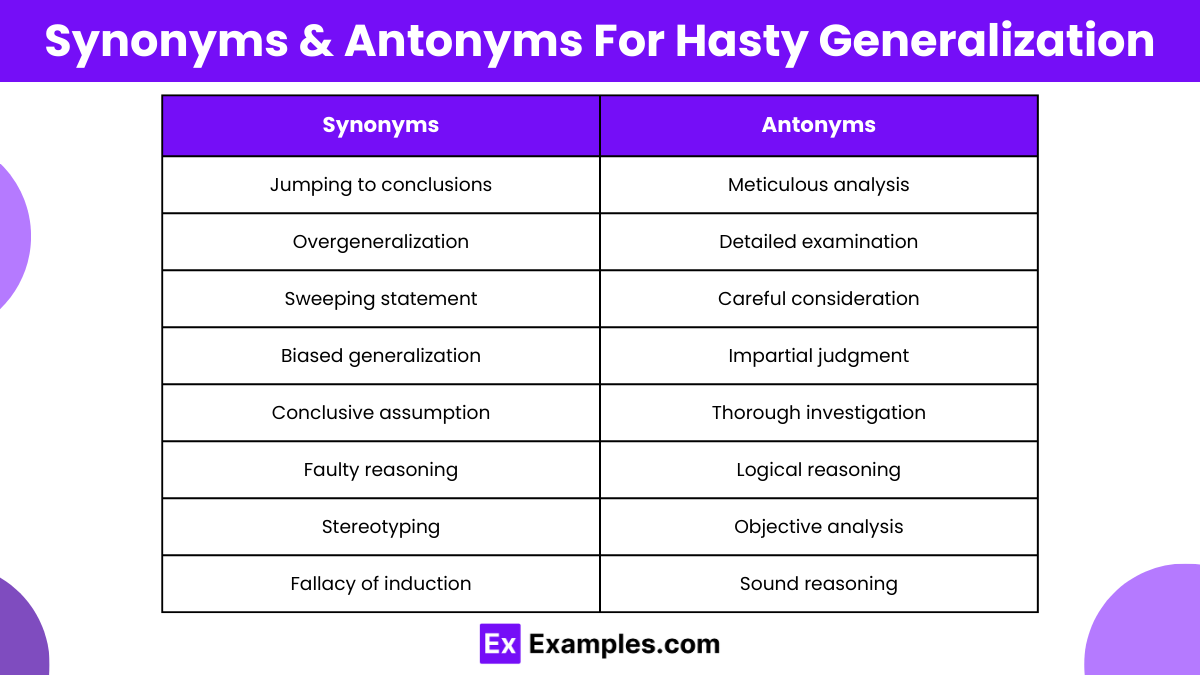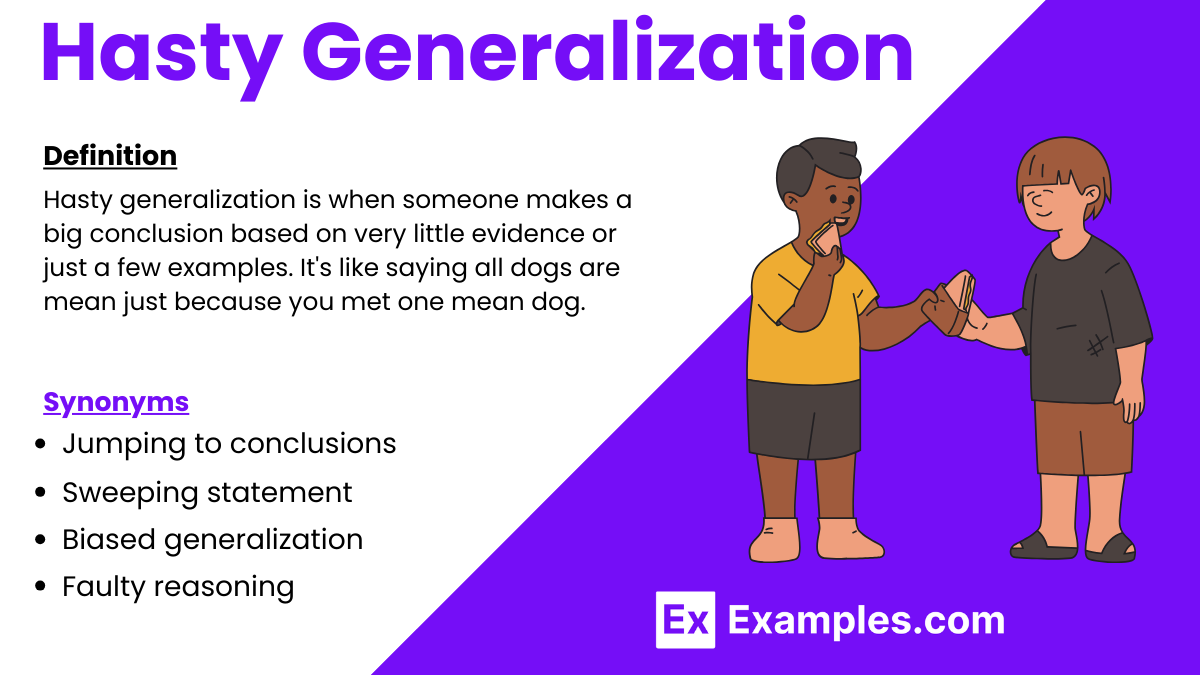60+ Hasty Generalization Examples
Hasty generalization is like making a quick sketch of a person based on just one feature. It happens when we form a quick opinion about a whole group or situation using very limited information. For example, if you eat a bad apple and decide all apples from that orchard are sour, you’re making a hasty generalization. This rushed judgment can lead to incorrect conclusions because it doesn’t consider enough evidence or examples.
Understanding hasty generalization is important because it can affect how we view and interact with the world. It can lead to stereotypes or unfair assumptions about people, places, or things. By being aware of this, and questioning our quick judgments, we can make more accurate and fair decisions, avoiding misunderstandings and promoting better communication.
Hasty generalization is when someone quickly makes a broad conclusion without enough evidence. It’s like deciding something about a whole group based on just one example. For instance, saying “All swans must be white” after seeing only white swans is a hasty generalization. This jump to conclusions can lead to incorrect assumptions because it ignores broader, more varied evidence that might show a different story. Understanding this can help us avoid such errors in judgment, promoting more accurate and reasonable thinking.
How Does Hasty Generalization Works?
Hasty generalization works by making quick conclusions based on insufficient or selective evidence. This often happens when someone observes a limited number of instances and then extrapolates a general rule that applies to all similar cases. Here’s a step-by-step breakdown of how this fallacy typically unfolds:
- Observation: An individual observes a small sample or a single instance. For example, someone might see a few news reports about teenagers causing trouble and watch a couple of incidents in their neighborhood.
- Generalization: From this limited observation, the person concludes a general rule that applies to all similar situations or groups. In the given example, they might conclude, “All teenagers are troublemakers.”
- Application: This general rule is then applied to all future encounters with the subject. Whenever the person meets or hears about teenagers, they assume those teenagers must be troublemakers.
Characteristics Of Hasty Generalization

Hasty generalization has several key characteristics that make it easy to recognize in everyday reasoning and discussions. Understanding these traits helps in identifying and avoiding this logical fallacy:
- Limited Sample: The conclusion is based on an inadequate sample size that is too small to support the generalization being made.
- Lack of Evidence: There is insufficient evidence to support the sweeping conclusion. The evidence is either too weak or too sparse to be reliable.
- Overextension: Conclusions extend beyond the boundaries of the original observation, applying to a broader group or situation than the evidence justifies.
- Rushed Judgment: The generalization is made quickly, without consideration for variability, complexity, or potential counterexamples.
- Ignorance of Contradictions: Existing evidence that contradicts the generalization is ignored or overlooked, further skewing the reasoning.
- Stereotyping: Often, hasty generalizations lead to stereotypes, where specific traits are attributed to all members of a group based on the behavior of a few.
- Bias Influence: Personal biases or prejudices can drive hasty generalizations, as individuals may selectively use evidence that supports their pre-existing beliefs.
Synonyms & Antonyms For Hasty Generalization

| Synonyms | Antonyms |
|---|---|
| Jumping to conclusions | Meticulous analysis |
| Overgeneralization | Detailed examination |
| Sweeping statement | Careful consideration |
| Biased generalization | Impartial judgment |
| Conclusive assumption | Thorough investigation |
| Faulty reasoning | Logical reasoning |
| Stereotyping | Objective analysis |
| Fallacy of induction | Sound reasoning |
Synonyms
- Jumping to Conclusions: Making a decision or forming an opinion without having all the necessary information or without considering all the facts.
- Overgeneralization: Drawing a general rule from a single event or a few examples that are too specific to apply broadly.
- Sweeping Statement: A broad claim that oversimplifies the truth by ignoring exceptions and differing cases.
- Biased Generalization: Forming a general rule based on a skewed or prejudiced viewpoint, often ignoring any contradictory evidence.
- Conclusive Assumption: Making a final judgment or decision based on insufficient information, as if no further evidence is needed.
- Faulty Reasoning: Using flawed logic or reasoning that leads to incorrect conclusions.
- Stereotyping: Assuming that all members of a group share the same characteristics based on a limited observation.
- Fallacy of Induction: Incorrectly using specific instances to create a general rule, assuming that what is true for some cases must be true for all.
Antonyms
- Meticulous Analysis: Examining something very carefully, paying close attention to every detail before making a decision.
- Detailed Examination: Thoroughly looking at or considering all parts of something to understand it fully.
- Careful Consideration: Taking the time to think about something deeply, weighing all aspects before coming to a conclusion.
- Impartial Judgment: Making a decision or forming an opinion based solely on the facts, without any bias or personal preference.
- Thorough Investigation: Doing a complete and detailed study or examination to gather all relevant facts and data.
- Logical Reasoning: Using clear and rational thinking to form conclusions, ensuring that each step of the thought process is sound and valid.
- Objective Analysis: Assessing a situation or set of facts without letting personal feelings or prejudices influence the evaluation.
- Sound Reasoning: Basing conclusions on strong, reliable, and logical arguments or evidence.
Hasty Generalization vs. Faulty Generalization
| Features | Hasty Generalization | Faulty Generalization |
| Definition | Making quick conclusions based on limited evidence or examples, without considering all the facts. | Drawing conclusions that are unwarranted due to flawed reasoning or inadequate evidence. |
| Key Characteristics | Relies on small sample sizes<br>- Ignores diversity and variation<br>- Overgeneralizes from limited data | Involves flawed logic or reasoning<br>- Ignores contradictory evidence<br>- Makes sweeping conclusions without proper support |
| Example | “I met two people from France, and both were rude. Therefore, all French people must be rude.” | “My phone froze once, so all smartphones must be unreliable.” |
| Effects | Leads to stereotypes and biases, often resulting in unfair judgments and decisions. | Spreads misinformation and perpetuates false beliefs, which can harm relationships and communities. |
| Applications | Common in everyday conversations, media portrayals, and political rhetoric. | Found in advertisements, propaganda, and persuasive speeches. |
| Counterarguments | Emphasizes the importance of gathering more evidence and considering diverse perspectives. | Highlights the necessity of critical thinking and examining underlying assumptions. |
Examples of Hasty Generalization in Real life
- Stereotyping Based on Appearance: Assuming that all people who wear glasses are intelligent without considering individual differences or abilities.
- Judging Based on a Single Experience: Believing that all restaurants in a particular chain serve bad food because of one negative experience at one location.
- Political Generalizations: Assuming that all members of a political party hold the same beliefs and values based on the actions of a few representatives.
- Racial Stereotyping: Believing that all members of a certain race possess specific traits or behaviors based on anecdotal evidence or media portrayals.
- Age-Based Assumptions: Assuming that all teenagers are irresponsible because of the behavior of a few teenagers seen in the media.
- Professional Generalizations: Assuming that all lawyers are dishonest based on negative portrayals of lawyers in movies and TV shows.
- Economic Generalizations: Believing that all wealthy individuals are greedy and selfish, ignoring philanthropic efforts and diversity within the wealthy population.
- Gender Stereotypes: Assuming that all women are nurturing and emotional while all men are aggressive and unemotional, based on societal stereotypes.
- Educational Bias: Assuming that all students from a certain school are academically weak because of the reputation of the school.
- Cultural Assumptions: Believing that all people from a specific country behave in a certain way, ignoring the diversity of cultures and individuals within that country.
Examples of Hasty Generalization in Media
Hasty generalization, a common logical fallacy, frequently appears in media representations, shaping perceptions and reinforcing stereotypes. Here are examples of how it manifests:
- Villain Portrayals: Movies often depict villains from specific ethnic groups, leading to hasty assumptions about entire communities’ moral character.
- News Reporting: Sensationalized coverage of isolated incidents can unfairly generalize entire communities, perpetuating biases.
- Political Commentary: Media pundits may generalize entire political ideologies based on the actions of a few individuals, skewing public perception.
- Social Media Trends: Viral content can lead to hasty assumptions about entire demographics, disregarding individual diversity.
- Cultural Representation: Stereotypical portrayals in media reinforce hasty generalizations about behaviors and traits of certain cultures.
- Social Issues Coverage: Overemphasis on specific communities in coverage of social issues can lead to unfair generalizations about residents.
- Advertising Strategies: Advertisements sometimes rely on stereotypes, perpetuating hasty assumptions about consumer preferences.
- Protest Coverage: Media focus on isolated incidents during protests can lead to unfair generalizations about participants’ intentions.
- Gender Representation: Media often reinforces gender stereotypes, leading to hasty generalizations about men and women’s abilities.
- Mental Health Depictions: Oversimplified representations of mental health can perpetuate stigmatizing hasty generalizations.
Examples of Hasty Generalization in Advertising
- Gender Stereotyping: Ads portraying women as homemakers or men as breadwinners reinforce hasty assumptions about gender roles.
- Age-Based Assumptions: Targeting specific age groups with stereotypical portrayals, such as all older adults needing mobility aids, contributes to hasty generalizations about different demographics.
- Cultural Assumptions: Ads relying on cultural stereotypes perpetuate hasty generalizations about certain ethnic or cultural groups.
- Product Association: Associating a product with a particular lifestyle or personality type can lead to hasty generalizations about who should use it.
- Beauty Standards: Ads featuring only models with a certain appearance create hasty generalizations about beauty standards.
- Social Class Stereotyping: Depicting luxury products as symbols of success perpetuates hasty generalizations about social class.
- Health and Wellness: Implying a product is the key to optimal health without considering individual needs contributes to hasty generalizations about wellness solutions.
- Occupational Stereotypes: Ads showing only men in traditionally masculine occupations perpetuate hasty generalizations about career choices based on gender.
- Ethical Appeals: Making broad claims about a product’s environmental or social benefits without evidence can lead to hasty generalizations about a brand’s ethics.
- Brand Loyalty: Suggesting all consumers should prefer one brand over another based on vague claims reinforces hasty generalizations about consumer behavior.
Examples of Hasty Generalization in Movies
Hasty generalization, a common logical fallacy, often appears in movies, shaping audience perceptions and reinforcing stereotypes. Here are examples of how it manifests:
- Cultural Stereotypes: Portraying characters from specific cultures with exaggerated stereotypes, like associating all Italians with mafia activity, contributes to hasty generalizations about entire groups.
- Gender Roles: Depicting female characters as always needing rescue or solely focused on romance perpetuates hasty generalizations about women’s abilities.
- Racial Tropes: Assigning certain characteristics to characters based on race, such as all Asian characters being martial arts experts, reinforces hasty generalizations about racial groups.
- Occupational Stereotypes: Presenting characters in specific professions with one-dimensional traits, like all lawyers being unethical, leads to hasty generalizations about those jobs.
- Age-Based Assumptions: Depicting older characters as always wise or younger ones as always rebellious perpetuates hasty generalizations about age demographics.
- Romantic Comedy Tropes: Using predictable plotlines in romantic comedies, like instant love after a “meet-cute,” reinforces hasty generalizations about relationships.
- Casting Choices: Casting actors from specific backgrounds in stereotypical roles perpetuates hasty generalizations about those groups.
- Physical Appearance: Associating certain traits with particular physical characteristics, such as villains having scars, reinforces hasty generalizations about appearance and morality.
- Socioeconomic Portrayals: Presenting characters from lower socioeconomic backgrounds as always morally superior perpetuates hasty generalizations about social class.
- Nationality Tropes: Depicting characters from specific countries with exaggerated behaviors leads to hasty generalizations about nationalities.
Examples of Hasty Generalization in Politics
- Party Affiliation: Assuming that all members of a political party hold the same beliefs and values based on the actions or statements of a few representatives.
- Policy Positions: Believing that all individuals who support a particular policy or initiative share the same motivations or interests without considering diverse perspectives.
- Voter Demographics: Making assumptions about the characteristics or preferences of all voters based on the behavior of a specific demographic group.
- Political Ideologies: Stereotyping individuals who identify with a certain political ideology as all being extreme or radical, ignoring the spectrum of beliefs within that ideology.
- Election Outcomes: Drawing broad conclusions about the electorate’s preferences or motivations based on the results of a single election or referendum.
- Media Bias: Assuming that all media outlets with a particular political leaning are biased or untrustworthy without considering the diversity of perspectives within the media landscape.
- Campaign Strategies: Believing that all candidates from a certain party use the same tactics or messaging strategies, overlooking the individuality of each campaign.
- Government Policies: Making sweeping judgments about the effectiveness or consequences of government policies without considering the complexity of the issues involved.
- International Relations: Assuming that all citizens of a particular country hold the same views or attitudes towards international affairs based on the actions of their government or leaders.
- Political Labels: Using labels such as “liberal” or “conservative” as shorthand for complex political beliefs, leading to oversimplified and hasty generalizations about individuals’ ideologies.
Examples of Hasty Generalization in Sentences
- “I met a rude person from France, so all French people must be rude.”
- “I tried sushi once and didn’t like it, so all Japanese food must be disgusting.”
- “I read a book by one author from this genre and found it boring, so all books in that genre must be dull.”
- “I saw a spider in my house, so all spiders must be dangerous.”
- “I had a bad experience with a used car, so all used cars must be unreliable.”
- “I heard one politician make a false statement, so all politicians must be dishonest.”
- “I went to one concert and didn’t enjoy it, so all concerts must be boring.”
- “I tried a new hairstyle and didn’t like it, so all hairstyles similar to it must be unflattering.”
- “I had a negative interaction with one person from that city, so everyone from that city must be rude.”
- “I sampled a dish from a certain cuisine and found it too spicy, so all food from that cuisine must be too spicy.”
Funny Examples Of Hasty Generalization
- “I tried one brand of instant coffee, and it was awful. All instant coffee must taste like dirt!”
- “I met one clumsy person who tripped over their own feet. Everyone must be a walking disaster waiting to happen!”
- “I saw one cat knock over a vase. Cats are clearly plotting world domination through destruction!”
- “I met a forgetful professor who couldn’t find their glasses. All academics must be absent-minded geniuses!”
- “I watched one horror movie, and now I’m convinced that every creaky floorboard in my house is haunted!”
- “I tried one new recipe, and it turned out terrible. I guess I’m destined to be a terrible cook forever!”
- “I encountered one bad driver on the road. Clearly, everyone with a driver’s license is an accident waiting to happen!”
- “I saw one bird steal a french fry. Birds must have formed an underground society dedicated to stealing our snacks!”
- “I met one person who hates chocolate. Clearly, they’re an alien in disguise!”
- “I had one bad haircut. I guess I’m doomed to a lifetime of terrible hair days!”
What are the effects of Hasty Generalization?
- Stereotypes and Bias: It can lead to the formation and perpetuation of stereotypes, reinforcing biased beliefs about certain groups or individuals.
- Unfair Judgments: Hasty generalizations often result in unfair judgments and decisions based on limited or flawed information.
- Miscommunication: It can contribute to misunderstandings and miscommunication by oversimplifying complex issues or ignoring individual differences.
- Damaged Relationships: Hasty generalizations can harm relationships by creating distrust and resentment between people or groups.
- Inaccurate Conclusions: It often leads to inaccurate conclusions and faulty reasoning, preventing individuals from seeing the full picture or considering alternative viewpoints.
What is an example of a Hasty Generalization Quizlet?
An example of a hasty generalization on Quizlet might be:
“I missed one class and still got an A on the test. Skipping class must not affect my grades at all!”
This statement makes a broad conclusion based on one isolated experience, ignoring the potential negative consequences of regularly skipping class.
Where is Hasty Generalization Used?
- Everyday Conversations: People often make quick judgments or assumptions based on limited experiences or information in casual conversations.
- Media Portrayals: Hasty generalizations are prevalent in media representations, shaping perceptions and reinforcing stereotypes.
- Political Rhetoric: Politicians and pundits may use hasty generalizations to make sweeping statements about entire groups of people or opposing ideologies.
- Advertising: Advertisements sometimes rely on hasty generalizations to appeal to target audiences by simplifying complex issues or promoting stereotypes.
- Social Media: Hasty generalizations abound on social media platforms, where viral content and quick judgments can spread rapidly.



